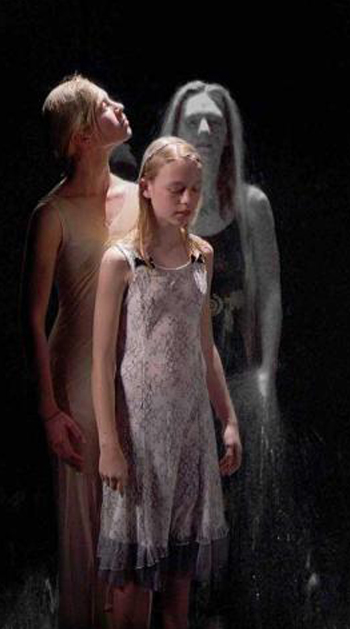Three Women, 2008/Color High-Definition video on plasma display mounted vertically on wall/61 ¼ x 36 3/8 x 5 in (155.5 x 92.5 x 12.7 cm)/9:06 minutes/Performers: Anika, Cornelia, Helena Ballent/Bill Viola Studio © Bill Viola.
In “Bill Viola: The Moving Portrait,” the Smithsonian’s National Portrait Gallery offers a new interpretation of the artist’s work, presenting it through the lens of portraiture and technology. The exhibition, the first of its kind for Viola’s work in Washington, includes 11 media pieces by the pioneering artist. Since the early 1970s, Viola has been recognized for his groundbreaking and masterful use of video technologies, creating works that explore the spiritual and perceptual side of human experience. The exhibition opened Nov. 18 and is on view through May 7, 2017.
“Bill Viola approaches portraiture in the spirit of the artists of the early Renaissance, where personal likeness combines with universal themes of spirituality and faith,” said Kim Sajet, director of the National Portrait Gallery. “His great gift is to take age-old questions about human experience and re-present them for contemporary life. He uses pixels instead of paint to connect people over time through the art of video. I am delighted to invite visitors to enter the museum’s newly created media galleries to experience portraiture in its most telling and current form: moving revelations of the human body and spirit that befit our digital age.”
Viola’s intimate studies of the human face and body depict a range of emotions, gradually revealed by his signature use of slow motion. Viola also turned the camera on himself, particularly in his early years of art-making, and several self-portraits will be on view. These works connect viewers of all backgrounds by using cutting-edge technology to create moving images that are emotional, searing and profound.
The earliest piece in the exhibition, “The Reflecting Pool” (1977–79), is a self-portrait exploring the notion of the perception of reality, and of the passage of time. “Time becomes extended and punctuated by a series of events seen only as reflections in the water,” Viola said.
Water themes course through Viola’s art. “The Raft” (May 2004), a large video/sound projection, depicts men and women from a variety of ethnic backgrounds caught in a catastrophic deluge that tests the human spirit.
Another room-sized work in the exhibition, “The Dreamers” (2013), uses seven plasma screens to portray people underwater in repose, fully clothed and with their eyes closed. Viola describes the piece: “Water ripples across their bodies, subtly animating their movements. The sound of running water permeates the space as dreams filter though the room, drawing the viewer into this watery world.”
One of Viola’s most contemplative pieces, a commentary on the condition of aging, is his recent diptych, “Man Searching for Immortality/Woman Searching for Eternity” (2013). The portraits are projected onto two separate slabs of black granite; one shows a man and another a woman, each examining their aging naked body with a small light, “looking for evidence of disease or corruption. Thankful for life, they gradually dissolve back into the stone from where they came,” Viola said.
“Bill Viola: The Moving Portrait” has been curated by Asma Naeem, curator of prints, drawings and media art at the National Portrait Gallery, in consultation with Viola’s creative partner, Kira Perov, and Bill Viola Studio.
In conjunction with the exhibition, the museum displays the latest acquisition of media art to the Portrait Gallery’s permanent collection, Viola’s “Self Portrait, Submerged” (2013). John and Louise Bryson have funded the work.
Viola’s intimate studies of the human face and body depict a range of emotions, gradually revealed by his signature use of slow motion. Viola also turned the camera on himself, particularly in his early years of art-making, and several self-portraits will be on view. These works connect viewers of all backgrounds by using cutting-edge technology to create moving images that are emotional, searing and profound.
The earliest piece in the exhibition, “The Reflecting Pool” (1977–79), is a self-portrait exploring the notion of the perception of reality, and of the passage of time. “Time becomes extended and punctuated by a series of events seen only as reflections in the water,” Viola said.
Water themes course through Viola’s art. “The Raft” (May 2004), a large video/sound projection, depicts men and women from a variety of ethnic backgrounds caught in a catastrophic deluge that tests the human spirit.
Another room-sized work in the exhibition, “The Dreamers” (2013), uses seven plasma screens to portray people underwater in repose, fully clothed and with their eyes closed. Viola describes the piece: “Water ripples across their bodies, subtly animating their movements. The sound of running water permeates the space as dreams filter though the room, drawing the viewer into this watery world.”
One of Viola’s most contemplative pieces, a commentary on the condition of aging, is his recent diptych, “Man Searching for Immortality/Woman Searching for Eternity” (2013). The portraits are projected onto two separate slabs of black granite; one shows a man and another a woman, each examining their aging naked body with a small light, “looking for evidence of disease or corruption. Thankful for life, they gradually dissolve back into the stone from where they came,” Viola said.
“Bill Viola: The Moving Portrait” has been curated by Asma Naeem, curator of prints, drawings and media art at the National Portrait Gallery, in consultation with Viola’s creative partner, Kira Perov, and Bill Viola Studio.
In conjunction with the exhibition, the museum displays the latest acquisition of media art to the Portrait Gallery’s permanent collection, Viola’s “Self Portrait, Submerged” (2013). John and Louise Bryson have funded the work.

